engine Seat Ateca 2016 User Guide
[x] Cancel search | Manufacturer: SEAT, Model Year: 2016, Model line: Ateca, Model: Seat Ateca 2016Pages: 328, PDF Size: 6.32 MB
Page 42 of 328
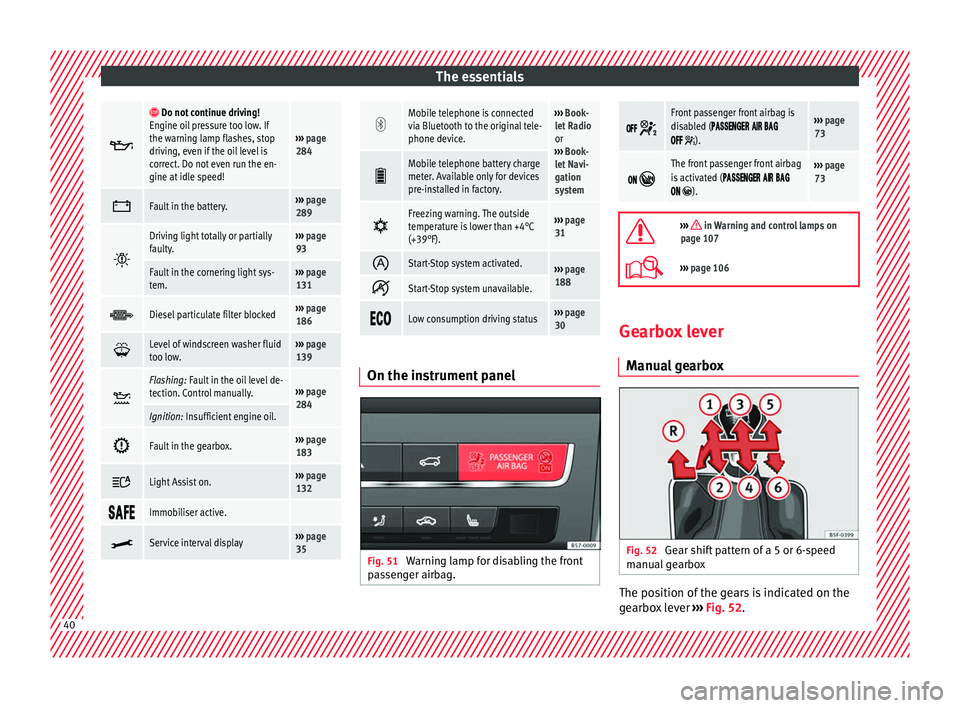
The essentials
ï¥ ï² Do not continue driving!
Engine oil pressure too low. If
the warning lamp flashes, stop
driving, even if the oil level is
correct. Do not even run the en-
gine at idle speed!
âºâºâº page
284 ï¦
Fault in the battery.âºâºâº
page
289 ï½
Driving light totally or partially
faulty.âºâºâº
page
93
Fault in the cornering light sys-
tem.âºâºâº page
131 ï·
Diesel particulate filter blockedâºâºâº
page
186 ï¹
Level of windscreen washer fluid
too low.âºâºâº
page
139 ï§
Flashing: Fault in the oil level de-
tection. Control manually.âºâºâº
page
284
Ignition: Insufficient engine oil. ï
Fault in the gearbox.âºâºâº
page
183 ï
Light Assist on.âºâºâº
page
132 ïïïï
Immobiliser active.
ï¤
Service interval displayâºâºâº
page
35 ïª
Mobile telephone is connected
via Bluetooth to the original tele-
phone device.âºâºâº
Book-
let Radio
or
âºâºâº Book-
let Navi-
gation
system ï
Mobile telephone battery charge
meter. Available only for devices
pre-installed in factory.
ï
Freezing warning. The outside
temperature is lower than +4°C
(+39°F).âºâºâº
page
31 ï¦
Start-Stop system activated.âºâºâº
page
188 ï§
Start-Stop system unavailable.
ï
ïï
Low consumption driving statusâºâºâº
page
30 On the instrument panel
Fig. 51
Warning lamp for disabling the front
p a
ssenger airbag. ïïï
ï¹
Front passenger front airbag is
disabled (ïïïïï
ïïï
ï ïïï ïïï
ïïï ï¹).
âºâºâº page
73 ïï
ï¶
The front passenger front airbag
is activated (ïïïïï
ïïï
ï ïïï ïïï
ïï ï¶).
âºâºâº page
73 ïª
âºâºâº in Warning and control lamps on
page 107
ï©âºâºâº page 106 Gearbox lever
M anua
l gearbox Fig. 52
Gear shift pattern of a 5 or 6-speed
m anual
gearbox The position of the gears is indicated on the
g
e
arbox lever âºâºâº Fig. 52.40
Page 45 of 328
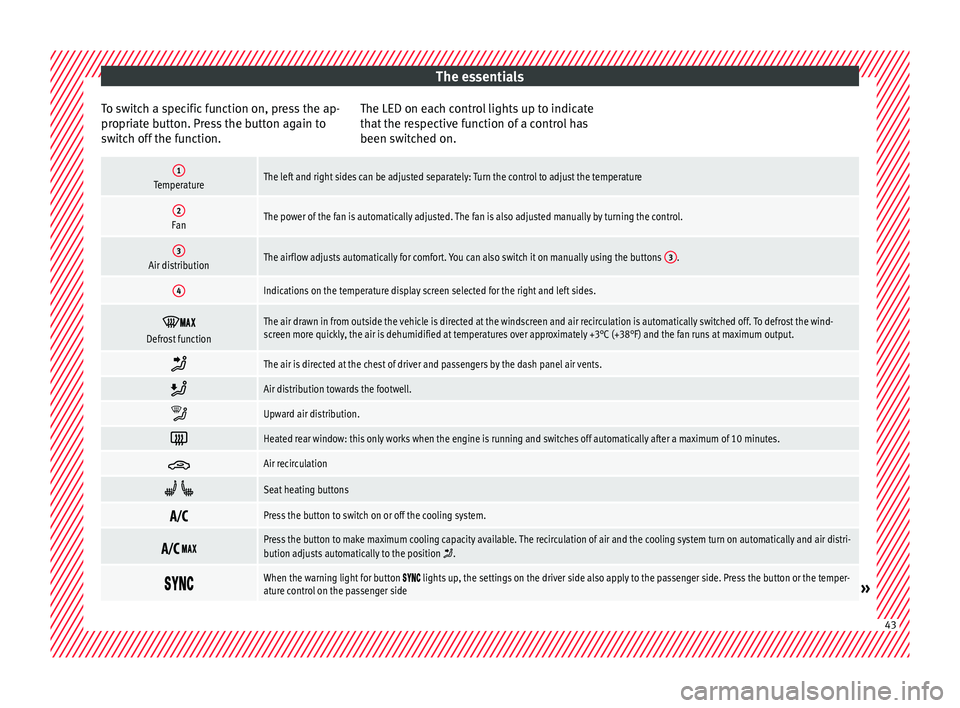
The essentials
To switch a specific function on, press the ap-
pr opri
ate button. Press the button again to
switch off the function. The LED on each control lights up to indicate
that
the respective function of a control has
been switched on.
1TemperatureThe left and right sides can be adjusted separately: Turn the control to adjust the temperature
2FanThe power of the fan is automatically adjusted. The fan is also adjusted manually by turning the control.
3Air distributionThe airflow adjusts automatically for comfort. You can also switch it on manually using the buttons 3.
4Indications on the temperature display screen selected for the right and left sides.ï
ïïï
Defrost functionThe air drawn in from outside the vehicle is directed at the windscreen and air recirculation is automatically switched off. To defrost the wind-
screen more quickly, the air is dehumidified at temperatures over approximately +3°C (+38°F) and the fan runs at maximum output. ï±
The air is directed at the chest of driver and passengers by the dash panel air vents.
ï²
Air distribution towards the footwell.
ï¨
Upward air distribution.
ï
Heated rear window: this only works when the engine is running and switches off automatically after a maximum of 10 minutes.
ï»
Air recirculation
ï¡ ï
Seat heating buttons
ï¾
Press the button to switch on or off the cooling system.
ï¾
ïïïPress the button to make maximum cooling capacity available. The recirculation of air and the cooling system turn on automatically and air distri-
bution adjusts automatically to the position ï±.
ïïïï
When the warning light for button ïïïï lights up, the settings on the driver side also apply to the passenger side. Press the button or the temper-
ature control on the passenger side» 43
Page 47 of 328

The essentials1TemperatureTurn the control to adjust the temperature
2FanSetting 0: blower and manual air conditioning switched off
Level 6: maximum fan level.
3Air distributionRotate the continuous control to direct the airflow to the desired area.
ï
Defrost functionThe airflow is directed at the windscreen. Air recirculation is automatically switched off or is not switched on. Increase the fan power to clear the
windscreen of condensation as soon as possible. To dehumidify the air, the cooling system will automatically switch on.
ï±
The air is directed at the chest of driver and passengers by the dash panel air vents.
ï´
Distribution of air towards the chest and the footwell area.
ï²
Air distribution towards the footwell.
ï·
Air distribution towards the windscreen and the footwell.
ï
Heated rear window: this only works when the engine is running and switches off automatically after a maximum of 10 minutes.
ï»
Air recirculation
ï¡
ï
Seat heating buttons ï¾
ïïïMaximum cooling power. The recirculation of air and the cooling system turn on automatically and air distribution adjusts automatically to the
position ï±
ïª
âºâºâº in Introduction on page 157
ï©âºâºâº
page 156 45
Page 49 of 328
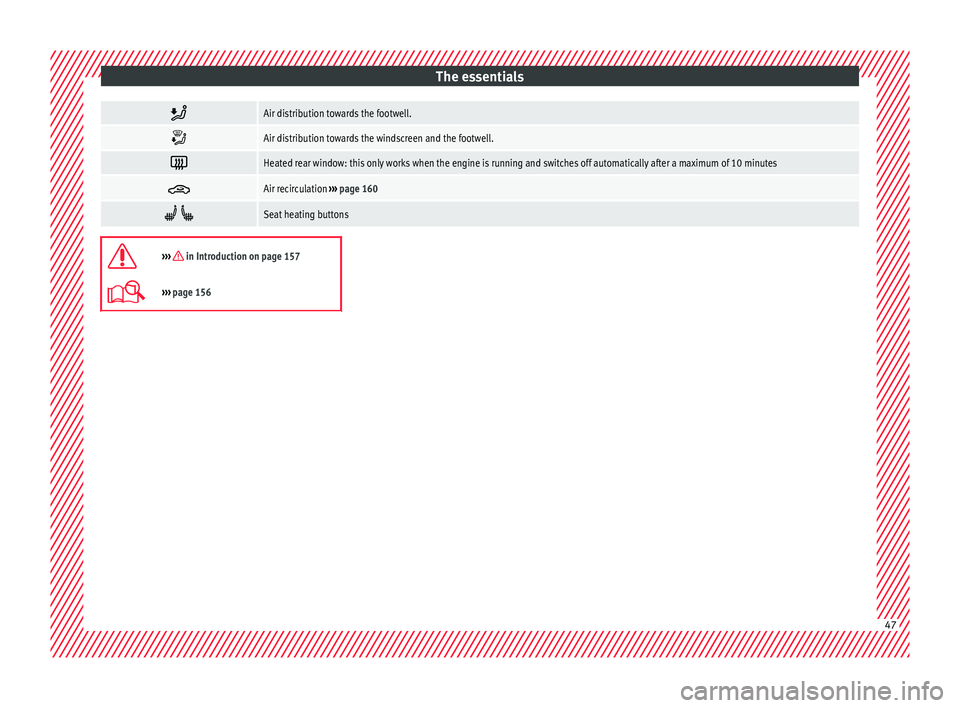
The essentials
ï²Air distribution towards the footwell.
ï·
Air distribution towards the windscreen and the footwell.
ï
Heated rear window: this only works when the engine is running and switches off automatically after a maximum of 10 minutes
ï»
Air recirculation
âºâºâº page 160 ï¡ ï
Seat heating buttons
ïª
âºâºâº in Introduction on page 157
ï©âºâºâº
page 156 47
Page 50 of 328
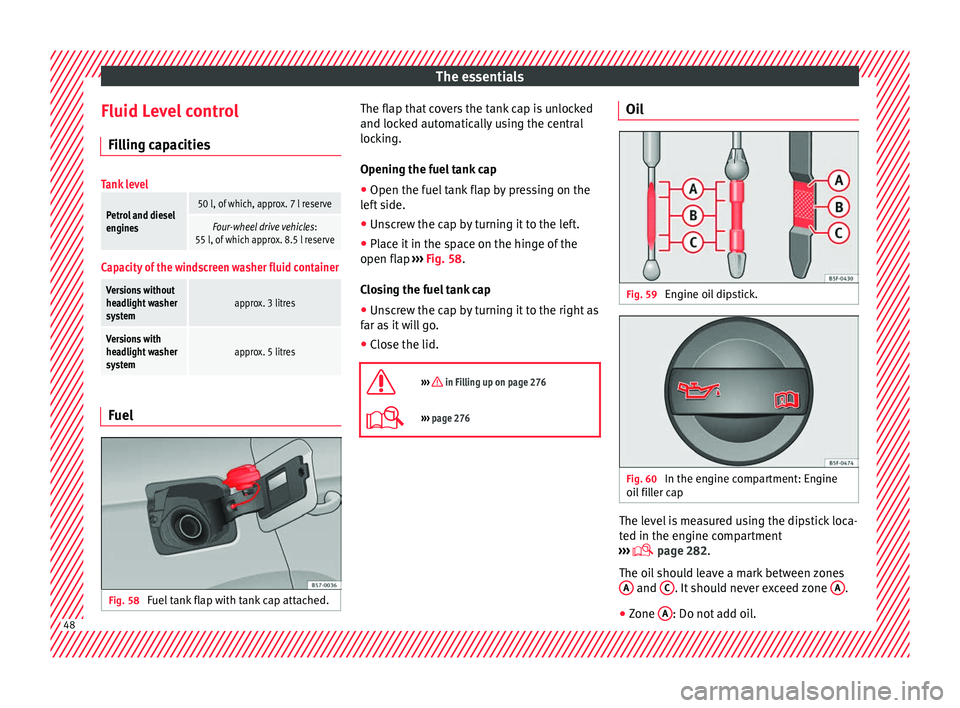
The essentials
Fluid Level control Fi l
ling capacities
Tank level
Petrol and diesel
engines50 l, of which, approx. 7 l reserve
Four-wheel drive vehicles :
55 l, of which approx. 8.5 l reserve
Capacity of the windscreen washer fluid container
Versions without
headlight washer
systemapprox. 3 litres
Versions with
headlight washer
systemapprox. 5 litres Fuel
Fig. 58
Fuel tank flap with tank cap attached. The flap that covers the tank cap is unlocked
and loc
k
ed automatically using the central
locking.
Opening the fuel tank cap
â Open the fuel tank flap by pressing on the
lef
t side.
â Unscrew the cap by turning it to the left.
â Place it in the space on the hinge of the
open flap âº
âºâº Fig. 58.
Closing the fuel tank cap
â Unscrew the cap by turning it to the right as
far a
s it will go.
â Close the lid.
ïª
âºâºâº in Filling up on page 276
ï©âºâºâº page 276 Oil
Fig. 59
Engine oil dipstick. Fig. 60
In the engine compartment: Engine
oi l
filler cap The level is measured using the dipstick loca-
t
ed in the en
gine compartment
âºâºâº ï© page 282.
The oil should leave a mark between zones A and
C . It should never exceed zone
A .
â Zone A : Do not add oil.
48
Page 51 of 328
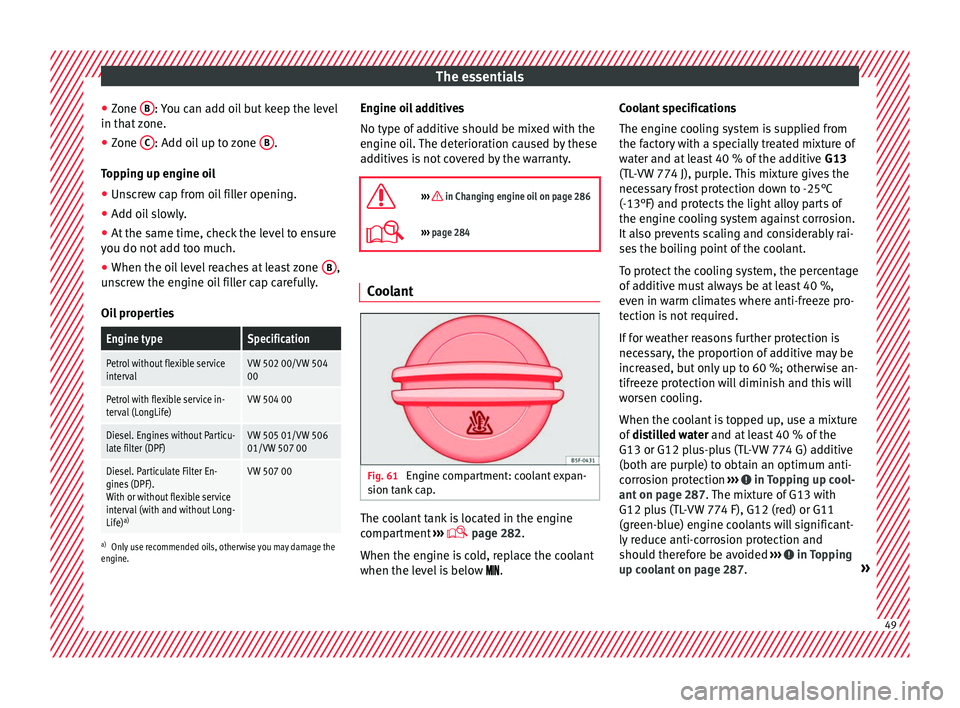
The essentials
â Zone B : You can add oil but keep the level
in th at
zone.
â Zone C : Add oil up to zone
B .
T op
ping up engine oil
â Unscrew cap from oil filler opening.
â Add oil slowly.
â At the same time, check the level to ensure
you do not
add too much.
â When the oil level reaches at least zone B ,
u n
screw the engine oil filler cap carefully.
Oil properties
Engine typeSpecification
Petrol without flexible service
intervalVW 502 00/VW 504
00
Petrol with flexible service in-
terval (LongLife)VW 504 00
Diesel. Engines without Particu-
late filter (DPF)VW 505 01/VW 506
01/VW 507 00
Diesel. Particulate Filter En-
gines (DPF).
With or without flexible service
interval (with and without Long-
Life) a)VW 507 00
a)
Only use recommended oils, otherwise you may damage the
engine.
Engine oil additives
No type of additive should be mixed with the
engine oil. The deterioration caused by these
additives is not covered by the warranty.
ïª
âºâºâº in Changing engine oil on page 286
ï©âºâºâº page 284 Coolant
Fig. 61
Engine compartment: coolant expan-
s ion t
ank cap. The coolant tank is located in the engine
c
omp
artment âºâºâº
ï© page 282.
When the engine is cold, replace the coolant
when the level is below ïïï. Coolant specifications
The engine c
ooling system is supplied from
the factory with a specially treated mixture of
water and at least 40 % of the additive G13
(TL-VW 774 J), purple. This mixture gives the
necessary frost protection down to -25°C
(-13°F) and protects the light alloy parts of
the engine cooling system against corrosion.
It also prevents scaling and considerably rai-
ses the boiling point of the coolant.
To protect the cooling system, the percentage
of additive must always be at least 40 %,
even in warm climates where anti-freeze pro-
tection is not required.
If for weather reasons further protection is
necessary, the proportion of additive may be
increased, but only up to 60 %; otherwise an-
tifreeze protection will diminish and this will
worsen cooling.
When the coolant is topped up, use a mixture
of distilled water and at least 40 % of the
G13 or G12 plus-plus (TL-VW 774 G) additive
(both are purple) to obtain an optimum anti-
corrosion protection âºâºâº in Topping up cool-
ant on p ag
e 287. The mixture of G13 with
G12 plus (TL-VW 774 F), G12 (red) or G11
(green-blue) engine coolants will significant-
ly reduce anti-corrosion protection and
should therefore be avoided âºâºâº in Topping
up c oo
lant on page 287. » 49
Page 52 of 328
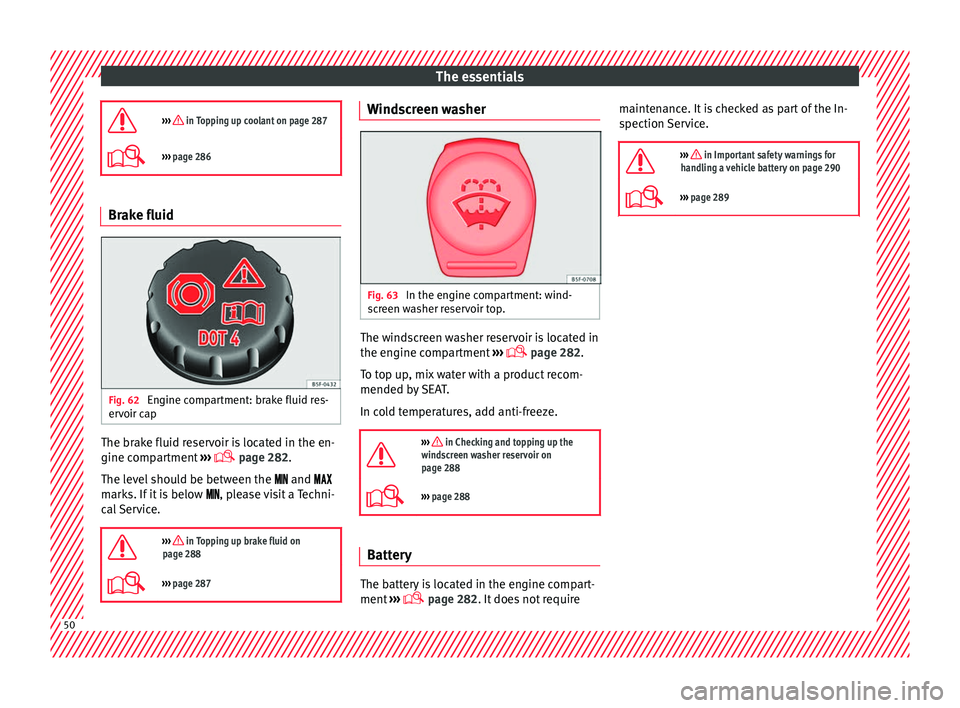
The essentials
ïªâºâºâº in Topping up coolant on page 287
ï©âºâºâº page 286 Brake fluid
Fig. 62
Engine compartment: brake fluid res-
er v
oir cap The brake fluid reservoir is located in the en-
gine c
omp
artment âºâºâº
ï© page 282.
The level should be between the ïïï and ïïï
marks. If it is below ïïï, please visit a Techni-
cal Service.
ïª
âºâºâº in Topping up brake fluid on
page 288
ï©âºâºâº page 287 Windscreen washer
Fig. 63
In the engine compartment: wind-
s c
reen washer reservoir top. The windscreen washer reservoir is located in
the en
gine c
ompartment âºâºâº
ï© page 282.
To top up, mix water with a product recom-
mended by SEAT.
In cold temperatures, add anti-freeze.
ïª
âºâºâº in Checking and topping up the
windscreen washer reservoir on
page 288
ï©âºâºâº page 288 Battery
The battery is located in the engine compart-
ment
âº
âºâº ï© page 282. It does not require maintenance. It is checked as part of the In-
spection
Service.
ïª
âºâºâº in Important safety warnings for
handling a vehicle battery on page 290
ï©âºâºâº page 289 50
Page 53 of 328

The essentials
Emergencies F u
ses
Fuse location Fig. 64
On the driver-side dash panel: fuse
bo x
cover Fig. 65
In the engine compartment: fuse box
c o
ver Underneath the instrument panel
The f
u
se box is located behind the storage
compartment âºâºâº Fig. 64.
In the engine compartment
Press the locking tabs to release the fuse box
cover âºâºâº Fig. 65.
Identifying fuses situated below the dash
panel by colours
ColourAmp rating
Black1
Purple3
Light brown5
Brown7.5
Red10
Blue15
Yellow20
White or transparent25
Green30
Orange40 ïª
âºâºâº in Introduction on page 90
ï©âºâºâº
page 90 Replacing a blown fuse
Fig. 66
Image of a blown fuse Preparation
â Switch off the ignition, lights and all elec-
tric al
equipment.
â Open the corresponding fuse box
âºâº
âº ï© page 91.
Identifying a blown fuse
A fuse is blown if its metal strip is ruptured
âºâºâº Fig. 66.
â Point a lamp at the fuse to see if it has
blo
wn.
To replace a fuse
â Remove the fuse.
â Replace the blown fuse by one with an
identic
al amperage rating (same colour and
markings) and identical size. » 51
Page 55 of 328
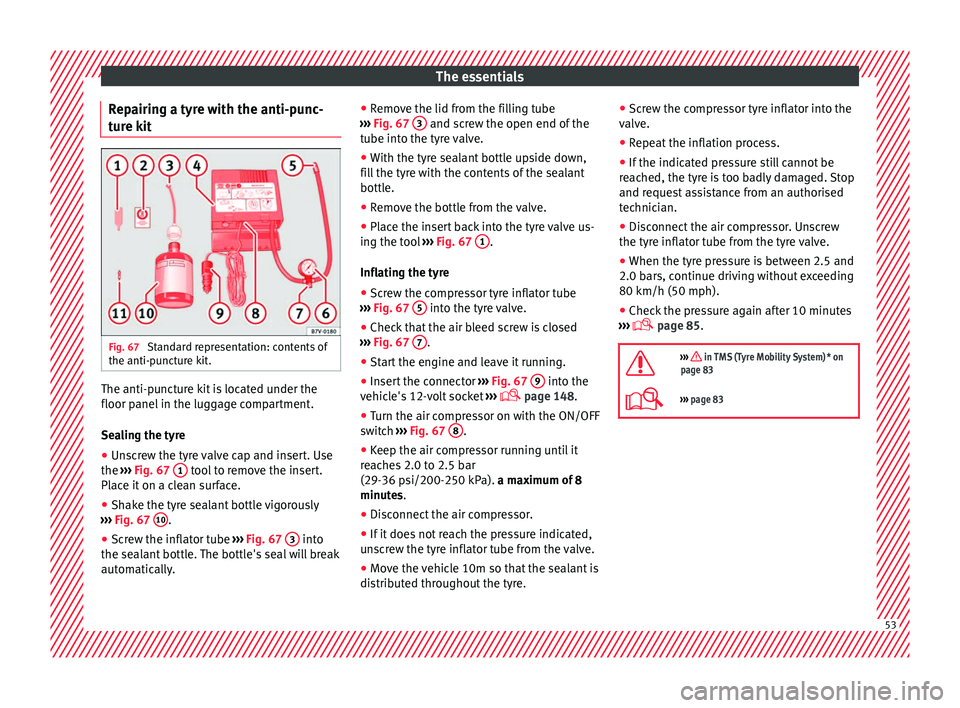
The essentials
Repairing a tyre with the anti-punc-
t ur
e kit Fig. 67
Standard representation: contents of
the anti-p u
ncture kit. The anti-puncture kit is located under the
floor p
anel
in the luggage compartment.
Sealing the tyre
â Unscrew the tyre valve cap and insert. Use
the âºâº
⺠Fig. 67 1 tool to remove the insert.
Pl ac
e it on a clean surface.
â Shake the tyre sealant bottle vigorously
âºâº
⺠Fig. 67 10 .
â Screw the inflator tube âºâº
⺠Fig. 67 3 into
the se al
ant bottle. The bottle's seal will break
automatically. â
Remo
ve the lid from the filling tube
âºâºâº Fig. 67 3 and screw the open end of the
t ube int
o the tyre valve.
â With the tyre sealant bottle upside down,
fil
l the tyre with the contents of the sealant
bottle.
â Remove the bottle from the valve.
â Place the insert back into the tyre valve us-
ing the t
ool âºâºâº Fig. 67 1 .
Infl atin
g the tyre
â Screw the compressor tyre inflator tube
âºâº
⺠Fig. 67 5 into the tyre valve.
â Check that the air bleed screw is closed
⺠âº
⺠Fig. 67 7 .
â Start the engine and leave it running.
â Insert the connector âºâº
⺠Fig. 67 9 into the
v ehic
le's 12-volt socket âºâºâº
ï© page 148.
â Turn the air compressor on with the ON/OFF
swit
ch âºâºâº Fig. 67 8 .
â Keep the air compressor running until it
r e
aches 2.0 to 2.5 bar
(29-36 psi/200-250 kPa). a maximum of 8
minutes.
â Disconnect the air compressor.
â If it does not reach the pressure indicated,
un
screw the tyre inflator tube from the valve.
â Move the vehicle 10m so that the sealant is
di s
tributed throughout the tyre. â
Sc r
ew the compressor tyre inflator into the
valve.
â Repeat the inflation process.
â If the indicated pressure still cannot be
re
ached, the tyre is too badly damaged. Stop
and request assistance from an authorised
technician.
â Disconnect the air compressor. Unscrew
the tyr
e inflator tube from the tyre valve.
â When the tyre pressure is between 2.5 and
2.0 bar
s, continue driving without exceeding
80 km/h (50 mph).
â Check the pressure again after 10 minutes
âºâº
âº ï© page 85.
ïª
âºâºâº in TMS (Tyre Mobility System)* on
page 83
ï©âºâºâº page 83 53
Page 60 of 328
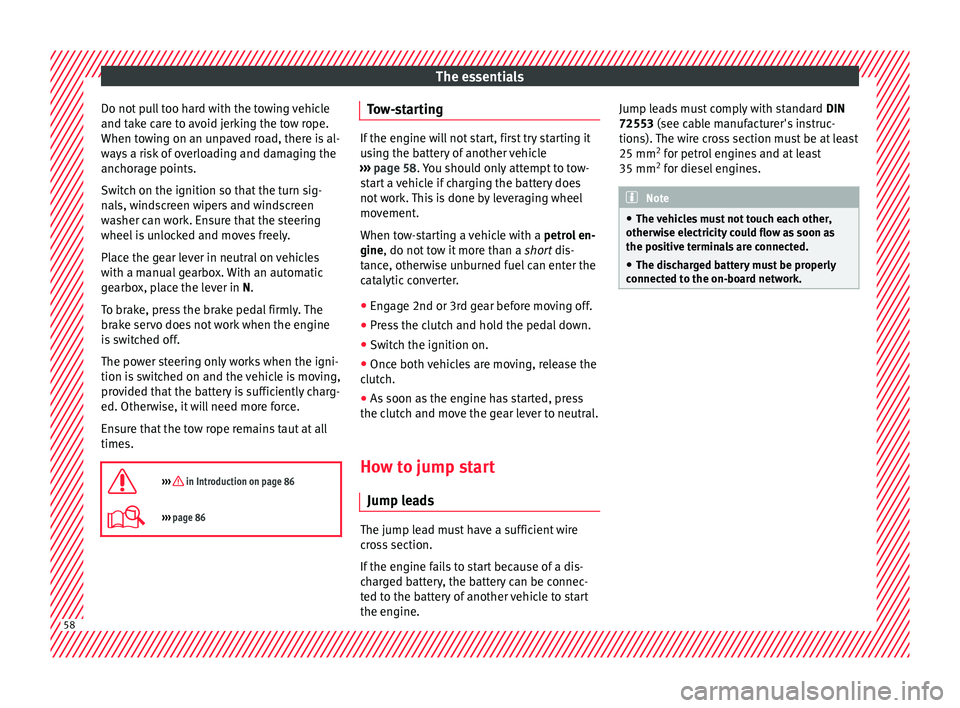
The essentials
Do not pull too hard with the towing vehicle
and t ak
e care to avoid jerking the tow rope.
When towing on an unpaved road, there is al-
ways a risk of overloading and damaging the
anchorage points.
Switch on the ignition so that the turn sig-
nals, windscreen wipers and windscreen
washer can work. Ensure that the steering
wheel is unlocked and moves freely.
Place the gear lever in neutral on vehicles
with a manual gearbox. With an automatic
gearbox, place the lever in N.
To brake, press the brake pedal firmly. The
brake servo does not work when the engine
is switched off.
The power steering only works when the igni-
tion is switched on and the vehicle is moving,
provided that the battery is sufficiently charg-
ed. Otherwise, it will need more force.
Ensure that the tow rope remains taut at all
times.
ïª
âºâºâº in Introduction on page 86
ï©âºâºâº page 86 Tow-starting
If the engine will not start, first try starting it
u
s
ing the battery of another vehicle
âºâºâº page 58. You should only attempt to tow-
start a vehicle if charging the battery does
not work. This is done by leveraging wheel
movement.
When tow-starting a vehicle with a petrol en-
gine, do not tow it more than a short dis-
tance, otherwise unburned fuel can enter the
catalytic converter.
â Engage 2nd or 3rd gear before moving off.
â Press the clutch and hold the pedal down.
â Switch the ignition on.
â Once both vehicles are moving, release the
c lut
ch.
â As soon as the engine has started, press
the clut
ch and move the gear lever to neutral.
How to jump start Jump le
ads The jump lead must have a sufficient wire
c
r
oss section.
If the engine fails to start because of a dis-
charged battery, the battery can be connec-
ted to the battery of another vehicle to start
the engine. Jump leads must comply with standard
DIN
72553 (see cab
le manufacturer's instruc-
tions). The wire cross section must be at least
25 mm 2
for petrol engines and at least
35 mm 2
for diesel engines. Note
â The v
ehicles must not touch each other,
otherwise electricity could flow as soon as
the positive terminals are connected.
â The discharged battery must be properly
connect
ed to the on-board network.58